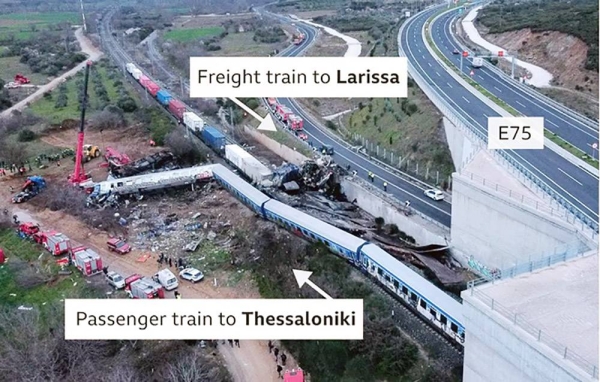
A drainage system wrongly built by Carillion and unchecked by Network Rail led to the Stonehaven train crash, investigators have found, when a Scotrail train hit debris washed by rain on to the railway track.
Three people died on 12 August 2020 in the worst fatal event on the UK railways in 18 years, when the passenger train from Aberdeen to Glasgow derailed at Carmont, near Stonehaven, after heavy rainfall.
Inspectors said the drainage system and earthworks, installed in 2011-12 by the contractor Carillion to stabilise the slope above the track, “had not been constructed in accordance with the original design and so were not able to safely accommodate the water flows” when almost a month’s rainfall, 51.5mm, fell in three hours.
The changes made by Carillion, which went bust in 2018, were not noted by Network Rail, which did not inspect the upper parts of the drainage system after a handover in 2013.
The Rail Accident Investigation Branch’s final report on the disaster also found that route controllers had “not been given the information, procedures or training needed” to effectively manage the situation, and that Network Rail had not fully implemented risk measures developed after previous events involving extreme weather.
Despite a nearby landslip the same morning, and floods from the extreme rainfall, no speed restrictions were imposed and the train was travelling at 73mph when it hit the gravel washed from the drainage trench and came off the tracks, striking a bridge parapet. One of the four carriages overturned and another fell down a steep embankment and caught fire.
The RAIB said the outcome would probably have been less severe for a more modern train with better “crashworthiness” than the 1970s-built HST model involved.
The train drivers’ union Aslef called for moves to start immediately to take the HST train type out of service.
The three people who died included two train staff: the driver, Brett McCullough, and the conductor, Donald Dinnie. One passenger, Christopher Stuchbury, died, and the other six people on the train were injured. The report said many more casualties could have arisen but for the low numbers travelling during the Covid-19 pandemic.
The RAIB’s chief inspector, Simon French, said the tragedy highlighted “the risk of uncontrolled changes to railway infrastructure during construction” and was “a reminder how potentially dangerous Britain’s volatile weather can be”.
French said the railway should “get even smarter about the way it counters this threat” and “urgent[ly] provide real-time decision-makers with the information, procedures and training they need”.
He said shutting down the railway during bad weather would force potential passengers on to roads, which were “undoubtedly much more dangerous”. But the accident should not be dismissed as a one-off event, he added, and the industry “needs to think through the implications of severe weather on its infrastructure”.
Andrew Haines, Network Rail’s chief executive, said the report showed there were “fundamental lessons to be learned by Network Rail and the wider industry”.
“As well as expressing our deep sorrow and regret … we acknowledge it should not have taken this tragic accident to highlight those lessons,” Haines said. “We must do better.”
He said they had invested tens of millions of pounds in improving rail’s resilience to weather, including inspecting similar locations and drainage systems across the country.
Mick Whelan, the general secretary of Aslef, the train drivers’ union, said: “The failures identified in this report are so bad that we believe this must be a watershed moment in the way we ensure the safety of passengers and staff on our railway network.”
ScotRail’s chief operating officer, Ian McConnell, said the report made for “very sober reading”, adding that while most of the RAIB’s recommendations related to other parties, “ScotRail will play its part fully in ensuring that safety lessons are learned … to do everything possible to reduce the risk of something like this ever happening again.”
Solicitors acting for relatives of a victim and for injured passengers said the report showed “a catalogue of failures within Network Rail”. Neil Davidson, a partner at law firm Digby Brown, said: “The RAIB investigation clearly shows rail management had prior knowledge of several known risks – they were told to improve, yet still failed to act. This is the very definition of negligence.”
The rail regulator, ORR, is conducting a separate investigation into the crash, with Police Scotland and the British Transport Police. It expects to hand over a final report to Scotland’s public prosecutor, the Crown Office and Procurator Fiscal Service, in the coming months.












